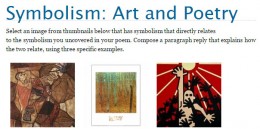This lesson is for : Grade 8:
Summary
Students will analyze poems and artwork to discover how the literary tone, mood, and theme are expressed in each. They will compare and contrast poetry and period art, and be able to justify why a particular piece of artwork would accurately symbolize the ideas in a poem written in or about the same era. Students will share information and compare and contrast their own perspectives with those of the artist, poet, and other students. The juxtaposition of English student evaluations of mood and tone with the art student evaluations in this lesson was quite powerful to students. The point that a clear theme and tone is evident to the trained (art students) and the untrained (English students) eyes and ears, when established effectively became salient to both groups students.
TIPC Ratings
Research & Information Fluency
Rating: N/A- Explanation: Research was not a focus for this lesson. As a result, the teacher preselected the images and poems used. Students then selected from the teacher created list of poems and images.
Communication & Collaboration
Rating: Ideal- Explanation: The class used a padlet to communicate with the group in the opener and then worked in small groups by choosing a partner who shared a similar evaluation of artwork in activity two. Students are engaged (asynchronously) with students in art classes to compare and contrast their learning within each content (art and English) via a collaborative WordPress blog. Students used the blog comments from English and art students to reflect on the relationships between art terminology and concept and literary devices, thereby deepening their understanding of literary tone, theme, etc. An exit ticket added supplemental reflection activities, centered on their role as communicators and collaborators. The juxtaposition of English student evaluations of mood and tone with the art student evaluations was quite powerful to students. The point that a clear theme and tone is evident to the trained (art students) and the untrained (English students) eyes and ears, when established effectively became salient to both groups students.
Critical Thinking & Problem Solving
Rating: Approaching – Explanation: Annotation and analysis of art and poetry requires students to think critically and engage in higher order questioning, as well as requiring them to justify their choices by identifying implicit and explicit support in the text or art. Evidence of student justification for their decision making can be found in the comments section of the class blog.
Creativity & Innovation
Rating: Approaching- Explanation: Students worked collaboratively to generate new ideas in regards to how elements of art and literature create meaning for the viewer. Students predicted the author’s, composer’s and artist’s intended tone using multiple examples in this lesson. They then applied their learning by annotating a poem to highlight the elements of tone that spoke to the student.






